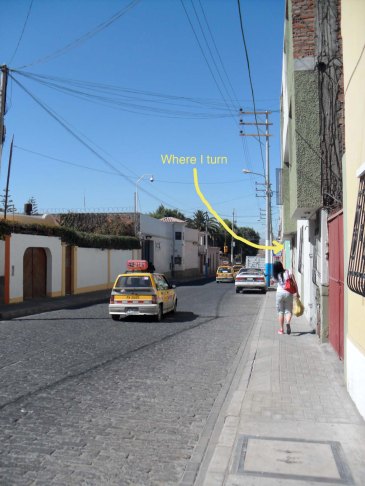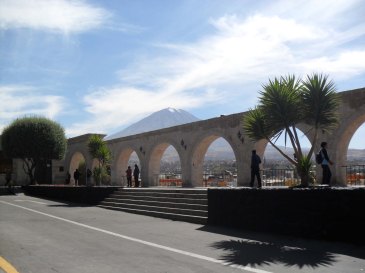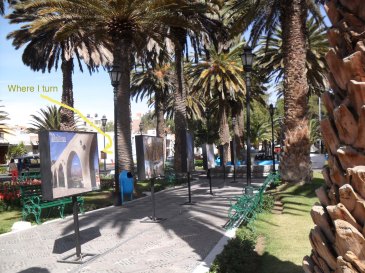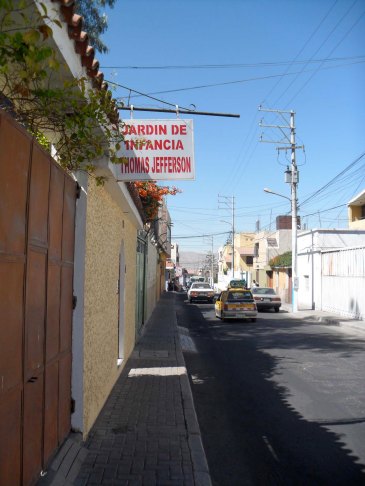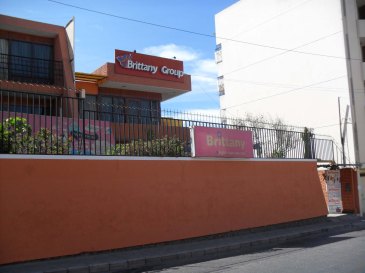Last weekend we finally got to do one of the main touristic attractions of Arequipa: hiking the Colca Canyon. We decided to do a three-day/two-night hike, and because we are both SERIOUSLY broke and I speak enough Spanish to understand directions we decided to go without a guide. That being said, I do not plan to go into specific detail about how to independently hike the Colca Canyon. It is pretty easily done with plenty of patience and an intermediate to advanced level of Spanish. It’s definitely better than going with a tour group since you can go at your own pace and stay where you’d like, so I completely suggest to anyone considering heading to the Colca Canyon to grab a friend and save some serious soles by striking out on your own. However, most of my readers (aka my family and some friends) aren’t planning a Colca trip, so the exact details of how to go independently won’t be very necessary.
If anyone came here for step-by-step instructions on how to do an independent trek of the Colca, there are some great resources online that I used. These two sites were really what I went off of, and they also provide links to the maps that we used to get around (although honestly, the maps are basically useless and you’re better off asking locals for directions):
Pachamama Hostel in Cabanaconde: http://www.pachamamahome.com/tours.htm
How to Hike the Colca Canyon, Without a Guide: http://theparallellife.com/2011/11/28/how-to-hike-colca-canyon-without-a-guide/
I will also gives some tips in the story below about some of the mistakes we made and lessons we learned, so hopefully someone can avoid making them! Let’s get started:
Day one of our Colca adventure started with us hailing a taxi at 12:30am in Arequipa. We had gone to the busport the day before to ask when the various bus companies left for Cabanaconde, the town nearest to the start of the canyon’s most popular hikes (S17 bus ride on Reyna). Turns out the buses left at either 1am or 8am, and since it’s a six hour ride, we opted with 1am to get an early start and beat some of the canyon’s infamous heat. Upon arriving in Cabanaconde with only three hours’ sleep, I fed a cute street dog some of my breakfast crackers and he followed us for three days. We asked directions to the Mirador de San Miguel at a hostel in Cabanaconde, which according to the above guides is the starting point for a hike down to San Juan de Chuccho. Turns out, it’s not that simple.
It took us about forty minutes to find the mirador, since (as with the rest of the country) the Colca Canyon has no way-finding signs. We had to hike out of town, along the main road, and then turn left before the soccer stadium to get to the mirador. Once there, we spent nearly another hour hiking up and down paths that seemed to lead from the mirador to nowhere. It doesn’t help that you can’t see the bottom of the canyon from the top since it’s over twice as deep as the Grand Canyon. Luckily, we saw another backpacking group with a guide walking past the soccer stadium and to a different cliffside. We surreptitiously followed them and found the actual trail, which was way more obvious.
Once we were on the right path, it was really hot and an incredibly steep three hour trek downhill. We met a man with two lazy eyes riding a donkey up the path who very kindly told us a safer way to go when we got to the bridge at the bottom of the canyon. Once we got to the bridge, we had to show our boleto turístico that we bought on the bus when we entered Cabanaconde (S70, the cost doubled this year). You need the ticket to get into the villages in the Colca and the Condor lookout. We took the much less steep path to the right after crossing the river, and hiked back up to San Juan de Chuccho were we slept the entire rest of the day at our hostel called Posada de Roy.
- Rooms at Posada de Roy.
I HIGHLY recommend that hostel!! It has the only private bathrooms in town, and quite possibly in the canyon. You do have to deal with bugs and spiders, but all the buildings in the canyon are made from adobe with thatch roofs, so that is to be expected. It was S20/person for a room and S10/person/meal which were delicious! The family was so kind, and spending the evening by candlelight since there was no electricity in town was something I had never had to do before. Smart tip: bring a flashlight, we forgot one which made getting around in the dark pretty hard.
The next morning we did not get going as early as we should have since we opted to sleep in until 8:30am and get moving around 9:30. Terrible idea! It was so very hot in the canyon by that time, and it only got hotter. The wife of the owner of our hostel gave me very long and specific directions to get to our next destination, and I am so glad she did! The path forks a lot, and it would be very easy to waste hours going in the wrong direction. When in doubt, take the path with the most hikers’ footprints. Unfortunately, we went during the off-season and almost no one was hiking the valley in early November so we had to mainly go with directions and guesswork.
As you can see from the first picture, we had to start the hike by going straight uphill to the next town of Coshñirwa. We were sweating and miserable by the time we got there an hour later, but luckily the path flattens out and the road to Malata (not pictured but it’s to the left of Coshñirwa) is pretty straightforward. From there, we had to hike all the way back down to the bottom of the canyon to cross another bridge over the river and then back up to our final Colca destination: Sangalle, aka The Oasis. All in all, day two took about three and a half hours to hike.
Once you get to the Oasis, if you take the lower path you walk straight through a hostel with two pools called Oasis Paraíso which I read was no good according to the blog I linked to above. We tried to explore around, but it is really hard to find the other hostels since there is no signage and so many trees in the Oasis. We finally found one after continuing to hike to the left (when facing Cabanaconde) and then down a flight of stone stairs to Paraíso Lodge, which was pretty nice. It had shared bathrooms, and the doors of the entire place were made of bamboo sticks which made it a little uncomfortable when people walked past the bathrooms and could look in and see you.
Paraíso Lodge cost the same as most of the hostels in the valley at S10/person for a room and S10/person/meal. It also offers a nice pool and a place to wash your laundry by hand. We were the only people at the hostel in San Juan de Chuccho, but there were many other groups with guides in Sangalle. We met a nice group that consisted of a few Germans, a guy our age from Austria, and a nice lady from France. It was fun to talk to other travelers and hear the conversation going in so many languages at once. Another tip: bring water purification tablets since water is S5 for a personal bottle and S10 for a 2.5 liter bottle. It was even S10 for a beer. Ouch!
The next morning we were smarter and started our hike out of the Colca Canyon at 5:30am. Even then, the hike is just wretched and you will sweat an insane amount and possibly want to lay down and cry. It took us nearly four hours to finally reach the top of the canyon, and it the weather was heating up at the end of it, even that early in the morning.
A big part of the trails down into the canyon and back up again look like this, and it’s the worst! Your muscles are already so exhausted, and having to lift your legs up at such uneven intervals and so constantly makes them give out even more. It got really disheartening at times to not be able to see the top, but we succeeded and it was a great feeling to finally be out of the canyon and head back into town. It wasn’t easy to get back though since we couldn’t find a clear path and ended up trekking through corn fields and hopping fences in people’s backyards.
We got back into Cabanaconde around 9:30am, bought tickets to return to Arequipa for 11:30am (S17 through Señor de los Milagros) and bought breakfast at a restaurant in the Plaza de Armas (S5). Final tip: do not take Milagros bus company, we stopped in the middle of nowhere and none of the drivers would tell us why. They locked the passengers in the bus cab and refused to answer anyone’s questions. We finally realized the bus must have broken down because they were pouring giant 2.5 liter bottles of water somewhere under the hood. After maybe 40 minutes, the drivers got back in the bus and drove off with the engine sounding very sick. The guy who was driving also decided it was better for the dying bus if he drove on the left side of the road and ignored the screams and poundings of the passengers yelling at him to drive in the right lane. I could constantly see an approaching car, bus, or big rig coming right for us, and then the driver would swerve out of the way at the last minute then go straight back into the left lane. It was a pretty terrifying two hour journey back to Arequipa, but we made it safe and sound with potentially a few more grey hairs from the experience.
In general, we are really glad we got to hike the Colca Canyon. It was exhausting and the return journey was quite scary, but now we know we can hike straight up a mountainside twice as deep as the Grand Canyon, so that’s pretty cool.



















































